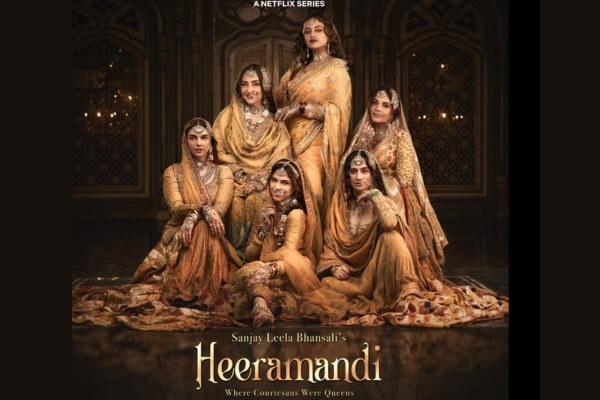Sanjay Leela Bhansali’s Heeramandi: The Diamond Bazaar is a cinematic spectacle that transcends time, bringing to life a world steeped in opulence, passion, and intrigue. Set against the backdrop of pre-independence Lahore, the narrative unfolds within the enigmatic confines of Heeramandi, the infamous red-light district that pulses with life and secrets. Bhansali, true to his signature style, paints a canvas of splendour, where the tawaifs (prostitutes), the Nawabs, and the British officers engage in a tumultuous dance of love, hatred, and longing for freedom.
For the audience, Heeramandi is a far cry from the real locale it portrays, which was once a much-maligned district. In his distinctive fashion, Sanjay Leela Bhansali crafts an alternate realm brimming with opulence. Here, amidst its lavish setting, thrive resilient and captivating women—both strong and beautiful—whose essence breathes jaan (life) into the heart of Heeramandi.
AT A GLANCE
SERIES: Heeramandi: The Diamond Bazaar (Netflix)
CAST: Manisha Koirala, Sonakshi Sinha, Fardeen Khan, Aditi Rao Hydari, Richa Chaddha, Taha Shah Badussha, Sharmin Segal, Adhyayan Suman, Indresh Malik, Jayati Bhatia, and Shekhar Suman
Duration: 8 Episodes
Creator: Sanjay Leela Bhansali
Rating: ***
Heeramandi is about its formidable women, led by the magnetic MallikaJaan, portrayed with haunting brilliance by Manisha Koirala. As the queen of Sheesh Mahal, she exudes power and authority, her past veiled in shadows of bloodshed and sacrifice. Alongside her are her daughters, Bibbojaan and Alamzeb, played by the beautiful Aditi Rao Hydari and Sharmin Segal respectively. Sonakshi Sinha commands the screen as Fareedan, driven by vengeance and a thirst for power, her presence casting a shadow over Heeramandi’s delicate balance. Richa Chaddha delivers a stellar performance as Lajjo, a tawaif consumed by love and longing for Nawab Zoravar, portrayed by Adhyayan Suman. Meanwhile, Mallikajaan’s sister Waheeda (played by Sanjeeda Sheikh) has guarded Mallika’s secrets, only to be left disappointed by Mallika’s ignorance towards her loyalty.

The Nawabs, too, are not without their complexities. Taha Shah Badussha impresses as Tajdaar, a secret freedom fighter torn between duty and desire, while Fardeen Khan embodies Nawab Wali Mohommad’s conflicted loyalties within Heeramandi with subtlety and depth. Shekhar Suman’s brief portrayal of Mallikajaan’s beau Nawab Zulfikar too is shrouded in mystery and passion.
From the moment it was conceived over 18 years ago, this project has been wrapped in anticipation, and now, as an 8-part series on Netflix, even with the grandeur of sets and some fine performances, Heeramandi disappoints on many levels.
While the initial two episodes set a grand stage and draw viewers into the intricate web of characters, it’s the introduction of Fareedan that adds a tantalizing twist to the narrative. However, as the story progresses, it loses momentum, particularly when attention shifts to the romantic subplot involving Tajdaar and Alamzeb, and shifting focus from micro: revenge saga within Heeramandi, to macro: Heeramandi’s reprisal against the British.
Unfortunately, Sharmin Sehgal’s portrayal of Alamzeb lacks depth, with her expressionless delivery hindering the overall impact of pivotal scenes. Additionally, the subplot focusing on MallikaJaan’s maids and a chaperone feels unnecessarily prolonged. The exaggerated efforts of some supporting characters to speak Urdu or Punjabi come across as more grating than intended.
In Heeramandi, the screen is illuminated by the stellar performances of Manisha Koirala, Sonakshi Sinha, and Aditi Rao Hydari, who breathe life into their characters with raw emotion and sensitivity. Koirala’s portrayal is particularly noteworthy, evoking memories of Khamoshi: The Musical her previous collaboration with Bhansali, showcasing her versatility as an actor, particularly in the scene where she demands, requests, and eventually pleads with Cartwright for her daughter’s innocence, only to be violated by him and his fellow officers.
After a hiatus of 14 years, Fardeen Khan’s understated yet impactful performance marks a winning return to the screen. Indresh Malik delivers a standout performance as Ustaad, adding layers of complexity to his character and leaving an indelible impression. While the series soundtrack may not be everyone’s cup of tea, Sakal Ban and Azaadi stand out as timeless classics, resonating with audiences long after the credits roll.
Bhansali weaves a tapestry of emotions, where love and betrayal intertwine against the backdrop of a nation on the cusp of change. With breathtaking visuals, haunting melodies, and powerhouse performances, the series is a testament to Bhansali’s mastery as a creator. There are particular scenes which will transport you back to the Pakeezah song Chalte Chalte, where you can see mujras (dance performances) taking place in different balconies or rooms within a frame.
It is a world of women where beauty and darkness collide, leaving an indelible mark on the viewer long after the final episode fades to black.
Read more: Review: Maidaan




